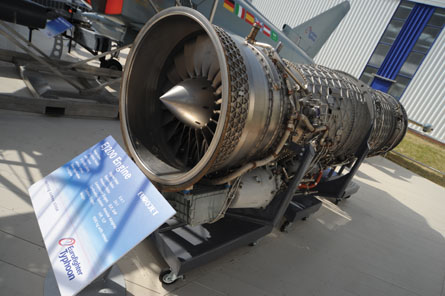Eurojet is to propose a thrust-vectoring version of the Eurofighter Typhoon's EJ200 powerplant to meet India's requirement for up to 150 engines to equip the first squadrons of its indigenously developed Tejas light combat aircraft (LCA).
The Aeronautical Development Agency - which is leading development of the Tejas - is expected to issue a request for proposals in the next few weeks, pitching the EJ200 against General Electric's F414.
The Eurojet partner companies have been working on thrust vectoring nozzle technology for several years, lead by Spanish manufacturer ITP, which validated the concept during a series of bench tests. Eurofighter majority stakeholder EADS is equipping a cockpit simulator at its Manching facility to demonstrate the potential performance enhancements.
 |
|---|
Thrust vectoring nozzle technology is being offered to the Eurofighter customer nations on the basis that it could significantly lower lifecycle costs by reducing fuel burn by "3-4% on an average mission" and extending the life of hot section parts, says Eurojet technical director Matt Price.
This is achieved by optimising nozzle shape throughout the flight envelope, and by eliminating the need for drag-inducing control surface deflections to trim the aircraft, particularly at supersonic speeds, where the aerodynamic centre moves aft, causing the nose to pitch down.
In addition, the technology can enhance agility, which could be of particular benefit to the Tejas as it is a delta-winged design that lacks canards.
EADS is leading the Eurofighter bid to win India's 126-aircraft medium multirole combat aircraft contest with the twin-engined Typhoon, and a deal to also equip the country's single-engined LCAs with the EJ200 would make the economics of establishing an in-country engine assembly line considerably more attractive.
The latest iteration of the Typhoon's flight-control system software has been designed to incorporate thrust-vectoring, and flight tests of the ITP thrust vectoring nozzle could begin within the next two years.
The flight-control system can be configured to use the thrust vectoring nozzle as an additional "control surface", boosting damage tolerance and reducing the risk of loss-of-control at low speeds, says Wolfgang Sterr, Eurojet engineering director EJ200/LCA. Furthermore, take-off distance for an aircraft such as the LCA could be reduced by around 20%, even in "hot and high" conditions, he adds.
Eurojet envisages a two-phase thrust vectoring nozzle flight-test programme, firstly using a twin-engine aircraft equipped with a single non-FCS-integrated thrust vectoring nozzle, followed by trials of the fully integrated system on both powerplants.
Source: Flight International























